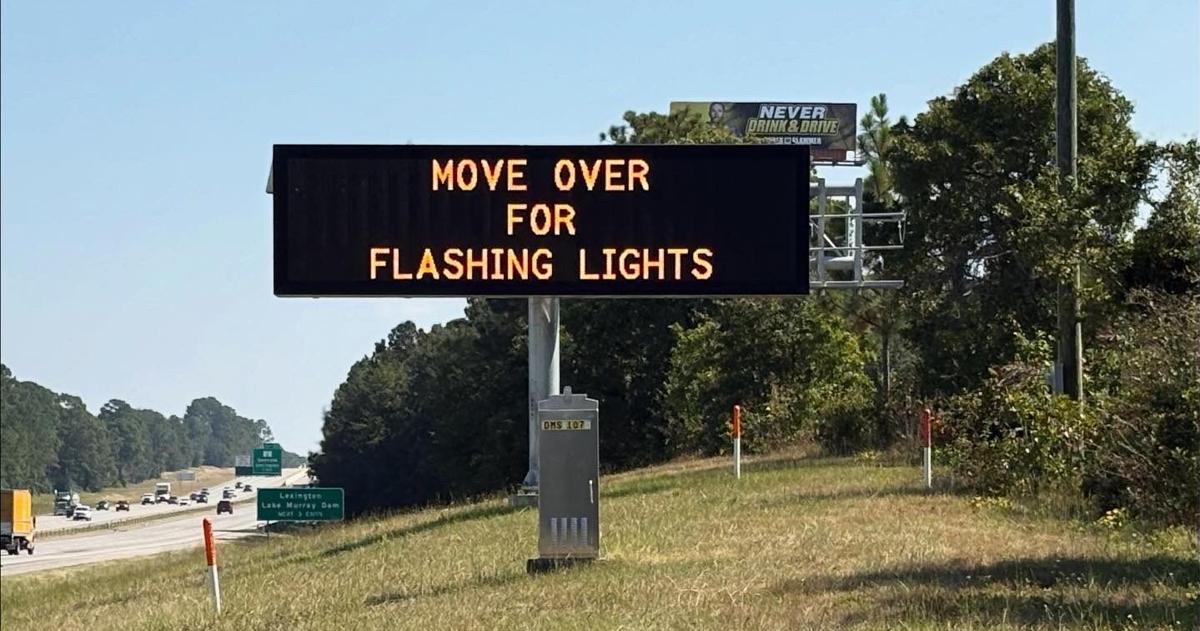
Multiple law enforcement agencies across several jurisdictions participated in the state Department of Public Safety’s campaign to raise awareness for laws enacted to keep emergency personnel and civilians safe along roadways.
A number of motorists were made aware of the laws via citations.
Operation “Keep Us Safe” ran from Sept. 15-19 in effort to make South Carolinians familiar with legislation both new and old designed to help reduce injuries and deaths that occur frequently along roadways.
“Getting in a vehicle — it’s the most dangerous thing a normal person will do on a daily basis,” said S.C. Highway Patrol Cpl. Nick Pye.
Of primary concern during the campaign was enforcing the state’s “Move Over” and “Hands-free” laws.
Enacted in 2002, the Move Over law mandates that drivers merge from the lane closest to stopped emergency vehicles whenever possible. If traffic, or the roadway design, doesn’t allow for merging, drivers must reduce their speeds and maintain control of their vehicles.
More recently, however, legislators passed the “Hands-free and Distracted Driving” Act. It took effect on Sept. 1, but punishments for violation will only begin to be doled out in the new year.
The law prohibits the use of any mobile devices and any device contact with a motorist’s body while driving the vehicle.
Keep Us Safe was initiated not long after a state Highway Patrol trooper was struck while conducting duties along an Upstate highway on Sept. 9. Days before that, another trooper had been injured. And before that, one died while conducting a traffic stop.
The death of Trooper First Class Dennis Ricks on Aug. 13 prompted statewide grief. The following injuries of Senior Trooper Mitchell Williams Jr. and Master Trooper Wayne H. LaBounty on Sept. 7 and Sept. 9, respectively, only furthered outcry and influenced authorities to find ways to increase education on the existence of driving legislation that protects motorists and emergency personnel alike.
During the enforcement operation, jurisdictions across the Palmetto State doled out more than 2,300 citations and hundreds of warnings.
Thousands of tickets issued
The S.C. Highway Patrol has jurisdiction over the entire state, especially on state-maintained roadways, to enforce traffic laws and conduct operations such as Keep Us Safe. As the piloting agency for the enforcement campaign, it dealt the largest number of warnings and citations to motorists during the Sept. 15-19 period.
Move Over law violations represented the vast majority of infractions caught by troopers during the five-day period, according to statistics provided by the SCDPS. The agency cited an average of around 350 drivers per day.
Some drivers were more fortunate: A little more than 550 motorists only received warnings for Move Over violations.
All sheriff’s offices in the Charleston tri-county area joined in on enforcement efforts. All told, the Charleston County, Berkeley County and Dorchester County sheriff offices issued nearly 100 Move Over citations and around 30 warnings collectively during enforcement operations, according to statistics provided by respective agency spokespeople.
How do officers actually enforce the law?
While, to many, Move Over mandates seem like common sense initiatives, violating the legislation carries a fine between $300 and $500 in South Carolina.
Fines certainly encourage adherence, but how exactly are officers to truly enforce the law? Not only is it difficult to prove if a driver could have safely merged lanes, the emergency personnel at risk are often too preoccupied to pursue a different vehicle believed to be in violation of Move Over principles.
For instance, SCDPS released a video Sept. 18 touting a success in “cracking down on those who don’t” adhere to the Move Over law, which included footage of a Highway Patrol trooper issuing a citation to a driver.
In the video, as the trooper speaks with occupants in the violating car, at least two vehicles race past the traffic stop without merging or slowing down.
Master Trooper William Bennett said situations like these are not uncommon. To enforce the Move Over law, all members of law enforcement must “work together and watch each other,” he said.
During the Keep Us Safe enforcement campaign, troopers utilized a buddy system, so to speak, to provide a watchful eye over one another and pursue Move Over violations in real-time, Bennett said.
Local jurisdictions implemented a similar tactic, called leapfrogging, said Cpl. Kristen Davis with the Dorchester County Sheriff’s Office. Multiple deputies will respond to an active roadside incident, taking post behind the emergency personnel conducting duties. This both protects all those involved in an active incident and allows for opportunities to enforce Move Over violations.
Dorchester County deputies conducted 102 traffic stops during their increased saturation effort on Sept. 17. Thirty-six Move Over citations resulted, according to officials.
But having multiple officers monitoring one another isn’t always feasible, thus members of the public must take it upon themselves to keep their own driving in check, both Bennett and Davis told The Post and Courier.
“We don’t want anyone to die out in a traffic collision. That’s why we do our job,” Bennett said. “But we’ve got to have help from the public to keep us safe … and it’s simple — it’s just slowing down and moving over.”
“Take that time. Be unselfish,” he said.
The easiest way to emphasize the importance of the Move Over mandate to put yourself in the shoes of an officer, Trooper Pye said.
Imagining yourself on the side of a highway with a flat tire as vehicles whiz past at 60-plus mph should be enough to understand the danger emergency personnel experience daily.
“Highway safety is a partnership between all law enforcement … but most importantly, it has to be a partnership with the motoring public as well,” Pye said.



